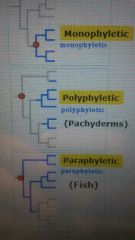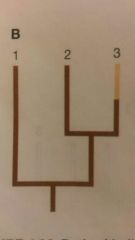![]()
![]()
![]()
Use LEFT and RIGHT arrow keys to navigate between flashcards;
Use UP and DOWN arrow keys to flip the card;
H to show hint;
A reads text to speech;
17 Cards in this Set
- Front
- Back
|
monophyletic group
|
a taxonomic group consisting of all descendants of the groups most common ancestor, and none else.
|
|
|
clade
|
consists of a group of species that share a single common ancestor
|
|
|
polyphyletic group
|

a disjointed group (pachyderms)
|
|
|
paraphyletic group
|
a group that contains the groups most common ancestor, but not all its descendants
|
|
|
cladograms
|
trees that do not have important branch lengths
|
|
|
phylograms
|
trees whose branch lengths represent evolutionary change
|
|
|
chronograms
|
trees whose branch lengths represent actual time
|
|
|
homologous trait
|
a trait that is found in two+ species because they were inherited from a common ancestor
|
|
|
analogous traits
|
shared by two+ species, but not derived from a common ancestor
|
|
|
divergent evolution
|
when closely related species diverge due to natural selection operating
|
|
|
convergent evolution
|
when two+ populations become more similar because of similar selective conditions
|
|
|
derived trait
|
a trait that that has evolved from another trait
|
|
|
synapomorphy
|

a shared, homologous, derived trait between two populations
|
|
|
homoplasy
|
a trait similar in two+ species with no common ancestor
|
|
|
symplesiomorphy
|

a recent trait that is not shared (leaving the ancestral trait more distantly related
|
|
|
polytomy
|
when relationships can't be determined
|
|
|
vestigial traits
|
traits that have no current function but appear to have been important in the evolutionary past
|

